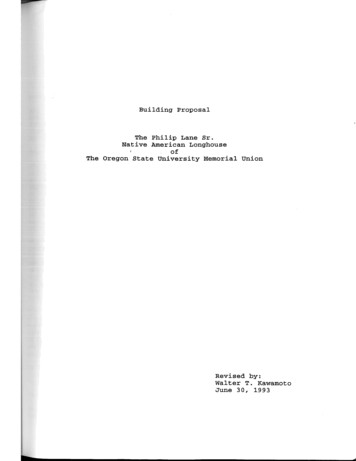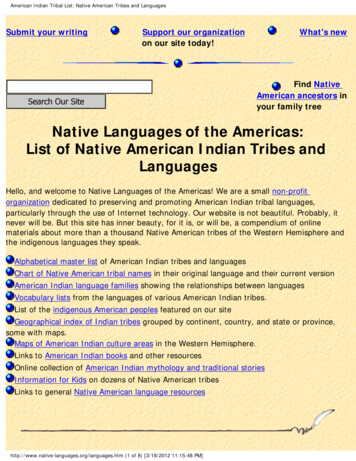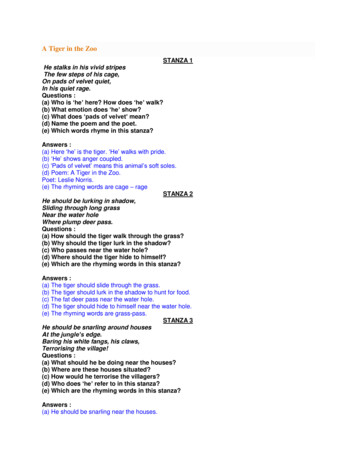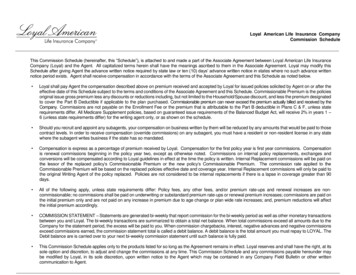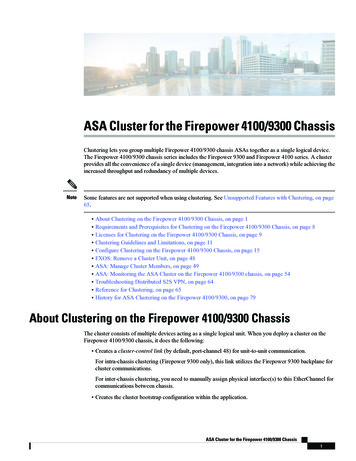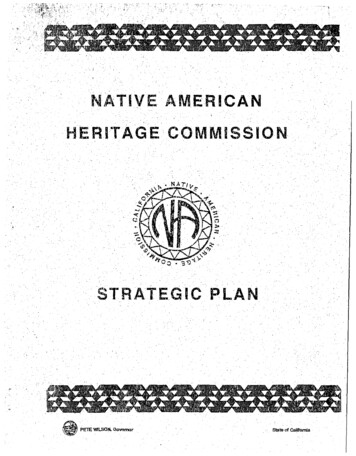
Transcription
NATIVE· AMERICANHERl&rAGE· COMMISSION.- . STRATEGIC. PLAN.· State of Cali!omla
Native American Heritage CommissionExecutive . SummaryThis strategic plan has been developed to focus the growth of the Native American Heritage Commission· to assist the public, the development community, local and federal agencies,. educatlorial. institutions andCalifornia Native; Americans to better understand problems relating to the protection and preservation;of cultural resources. It is hoped that this document will .serve as a tool to resolve these problems andcreate an awareness among lead agencies and developers of .the Importance of working with the peoplethat are directly affected by their actions. ·.This· strategic plan contains ten components. The mission statement, principl.es, yision, description,.assessment summary, goals, objectives and performance measures are the key elements tO this plan.The first three elements identify the reason the Commission· was created and the philosophy· and values. on which the Commission basis its operation.The program description is an important element because 'it describes the operations of the office. Theassessment summary· will provide the reader a clear understanding of the restrictions which the officeencounters and be pleased with the success that has been achieved in spite ofthe adversities.The identified goals and .objectives.g:ibeyond the duties and responsibilities identified in the Public-.Resources Code§ 5097.9 et.al. .The accomplishment of these goals will be a major step in achieving thevision as outlined in this plan . The final important· element is the performance measure' This tool evaluates the activities and effortsmade in achieving the goals and objectives. This plan is the Commission's hope for the future . ·
Native American Heritage CommissionTABLE OF CONTENTSExecutive Summary . .:.iTable. of Contents . .,. i i·Mission· Statement . . .,. 1Principles .;. .;. 2Vision .,.::.,·.;.,. 3Description. .,.;.:. 4Internal/External Assessment Summary.:. . 7Goals . . .8Objectives .;.8Performance Measures . .;. : . 8Resource .Assumptions . 1 0Financial .and. Full-time Equivalent Position Information .;. 10- ii
Native American Heritage CommssionMissionStatementThe Mission of the Native American Heritage Commission is to provide protection to Native Americanburials from vandalism and inadvert destruction, provide a procedure for the notification of mostlikely descendants regarding the discovery of Native American human remains and associated gravegoods, bring legal action to prevent severe and irreparable damage to sacred shrines, ceremonial sites,sanctified cemeteries and places of worship on public property, and maintain an inventory of sacredplaces.- 1
Native American Heritage CommssionPrinciplesThe Commission will exercise the following principles in an effort to be responsive to its internal andexternal communities:1. The Commission must be sensitive to all California Native Americans.2. The Commission will facilitate a cooperative working relationship with developers, privateland owners, local agencies, and the California Native American population.3.The Commission willadminister the thorough and complete application of the PublicResources Code §5097.9 et. al. and the Health and Safety Code §7050.5.4. The Commission will not express its opinion regarding recommendations for the treatmentand disposition of Native American human remains and associated grave goods.5. The Commission will not become involved in tribal politics.6. The Commission will treat all Native American groups, tribes, and individuals with respectand dignity.7. The Commission will conduct State business in a professional and sensitive manner.- 2
Native American Heritage CommssionVisionCalifornia Native American cultural resources, habitation sites, burial sites, sacred sites, ceremonialsites, and places of worship are limited resources for Indian and non-Indian people. They are importantto the culture and spiritual beliefs of California Native Americans. Therefore, they must be protected ina sensitive manner that involves local Native American people. An effective protection program w i 11benefit all citizens of California.Developers, private property owners, lead agencies, and law enforcement agencies will become awareof the importance of cultural resources to all the citizens of California. Additional State legislation andlocal ordinances will be enacted to more effectively protect cultural resources.Tribal governments, Indian organizations, and most likely descendants will become knowledgeable ofeffective mitigation measures, treatment and disposition of Native American human remains andassociated grave goods, protection of sacred places, and state and federal laws. All Native Americans w i 11be permitted access to burials, sacred sites, ceremonial places, and places of worship on public andprivate property. A cooperative working relationship among California Native Americans, developers,private property owners, and lead agencies will be established. This is a vision that all Californianswill come together to protect and preserve this valuable State heritage.- 3
Native American. Heritage bommssionDescriptionThe Native American Heritage Commission was established in 1976. It was created because CaliforniaNative Americans were demanding protection of their burial grounds from vandalism, destruction andscientific research. Many human remains were left baking in the sun by workers, as large burialmounds were uncovered during construction for housing and roads. These remains were simply ignored . by ttie workers ·or collected by archaeologists and amateur archaeologists .Thus, .the Commission was created by the Legislature and approved by the Administration in an effort torectify some of these ills. Under this program, California's most likely descendants have a voice indetermining the tre.atment and disposition of Native. American human remains. The right oi most ·likelydescendants to control analysis of Native American remains· was affirmed ·by the State Appellant Courtin a decision known as the 'Van Horn Case".In addition to the insensitive wholesale destruction of burial sites, archaeologists were collectingNativa American hum.an remains at an alarming rate. Remains were being warehoused at locationsacross California for future research projects. ,In many instances, curators and researchers had no ideahow many remains they had nor any province regarding the remains; The taking of these remains was acontinuation of the behavior toward Native Americans between 1850 and 1900.During the period between 1850 · to 1900, 90% of the California Indian population perished fromdisease, starvation, poisoning, or gun shot wound, but now people were collecting the human remainswithout any care, worry or concern for what the Native people were feeling or the religious baliefs ofthese people. All of this was legal; therefore, impossible for Native Americans to stop unUI appropriateIlegislation was passed.IIt has become imperative for the Commission to act as liaison in disseminating and interpreting laws,rules and procedures affecting the large number of federally recognized tribes, tribal groups applyingfor federal recognition, California Native American organizations, and individuals concerned with theprotection and involvement of Native American cultural resources and human remains. The Commissionis an essential hub for information flow. Many lead agencies .and developers are unaware of tribalconcerns and who to contact to solicit information regarding .impacts to cultural resources. Too often,- 4
Native American Heritage Commssiondevelopers are unaware of their responsibilities as defined in the Health and Safety Code and PublicResources Code that apply to cultural resources and the discovery of Native American .human remains .One of our prime quties continues to be the education of these people. There have been several occasionsin which· the coroners offices were not aware of the law. There has been some instances in which wehave met resistance from various coroners as to their responsibility as defined in the Health and SafetyCode.Our involveme.nt has not bee.n li.mited to working with developers and lead agencies. The Commissionworks closely with museums, community colleges, state universities, private universities, and theUniversity of California campuses. Our involvement often deals with the Native American Graves·Protection and Repatriation Act of 1990. Under this law, . museums, universities, and state agenciesthat receive federalfunds must complete inventory and summary reports of human remains, funerary·objects, objects of ·cultural patrimony, and sacred objects and must identify the culturally affiliatedtribalgroups. These agencies rely upon the Commission as a prime resource for assistance inidentifying and locating possible culturally affiliated tribal groups.The Native American Heritage Commission works cooperntively cin an ongoing basis withtheDepartments of Transportation, Parks and Recreation, Forestry and Fire Protection, Water Resources,Fish and Game, and California Arts Council.During the construction of the highway sy tem in California, many Native American burials wereunearthed. Today,.durini:J.repairs, replacement, or newconstruction, the Department of Transportationcontinues to.encounter Native American human remains, .associated burial goods, and impacts culturalresources. The office has assisted the Department of Transportation to develop an operations manual forl!Se of their employees regarding the discovery and protection of human remains and working with localtribes.The· Department of Parks and Recreation owns or manages many acres of land. Many of these parkscontain cultural resources and sacred/religious sites. The office is consulted by the department wheninterpretive centers are being developed. The office works closely to assure that tribal groups areincluded in the planning o cooperative working relationships are developed that wi.11 lead to accurateinformation regarding the local Native Americans customs and traditions.- 5
Native Ameriaan Heritage CommssionThe Department of Forestry and Fire Protection approves timber harvest plans on private land. Manyof the private lands contain cultural resources and Native American burial sites. The Commissioncontinues working with this department to develop timber harvest plans that contain regulations toavoid the destruction of sites and to protect burials. Efforts have been made to include Native Americanson the timber harvest review teams.At the request of local Indian people, this office has worked with· the Department of Fish and Game toremove the limitationsfor the collection· of seaweed. Native Americans· use this not only forconsumption, but in some instances it is used in ceremonies. The Department has removed itsrestrictions on Weight limitations and no impact to the seaweed environment has resulted.At-the federal level, this. office deals with the Bureau of Land Management, Forest Service, NationalPark Service, Bureau of Indian Affairs, Federal Highways Administration and Army Corps of Engineers.Occasionally, developers encounter Native American human remains and associated grave goods during .the development of a construction project. The number of human remains can range in the hundreds.The number of associated grave goods can be in the thousands. Discoveries of this nature requireextreme sensitive treatment. Many times disagreements between the most likely descendent and thedeveloper arise. This office works with both parties in an effort to resolve problems and identify acourse of action that is acceptable to everyone. Usually, the developer is concerned with added cost and· the projects public iniage. The most likely descendent is concerned with unwarranted removal ofburials and would like the project to be stopped or redesigned.Daily workload of. the office includes review of environmental impact reports · for projects on federalland and under state jurisdiction,negative declarations, mitigated negative declarations and timberharvest plans. The cultural resource s ction of each report is reviewed for adequate mitigation andverification if appropriate local tribal groups have been contacted regarding the project. Reports arealso checked against our sacred lands file.The office must also be responsible to the nine member Commission who convene in session to hear andact upon additional concerns that tribalrepresent different tribalgroups .and individuals present. The nine commissionersgroups, different perceptions and beliefs; therefore,responsive to concerns brought before them.- 6 are able to be
Native American Heritage CommssionInternal/ExternalAssessmentStrengths Established working relationship with coroners, developers, planners, property owners, andarchaeologists regarding discovery of Native American human remains and associated grave goods.Provide Native American Contact List to environmental firms, planners, and developers to enableconsultation with Native American individuals,. groups, and tribal governments regarding cultural resources .in project areas.Check Sacred Land File at request of environmental firms,recordation of site information for specific projects.planners, and developers to verifyIdentify Mos.t Likely Descendants pursuant to Public Resources Code §5097.98. discovery of human remains.(a),upon theProvide information regarding repatriation.Weaknesses Lack of Funds.1. Reduction in staff - from 5 to 3 .2. · Ability to travel to sites to assist in mediation of.sites withdevelopers, planning departments, and Native Americans.3. Need for services of an archaeologist lo assist in analyzing environmental documents and toconduct site inspections.4. Flexibility to call emergency commission meetings. One office in Sacramento which must serve the entire state.1. Ability to disseminate information to Native Americans and near concerns.2, Not accessible to all Native Americans.3. Not accessible to all develop1;Jrs and lead agencies. Ability to hire .outside legal .counsel when implementing Public Resources Code § 5097.97.1. Attorney General staff cannot legally represent Native American Heritage Commission incases involving public property and other state agencies.·- 7 '
Native American Heritage CommssionGoals, Objectives, and Performance MeasuresGoal:Promote adoption of protective measures by city/county agencies to protect culturalresources.Objective:Meet and confer with planning departments and other interested parties to assist in thedevelopment of local ordinances.Performance Measure:Meet and confer with 3 counties a year.Goal:Training for law enforcement agencies, public agencies, archaeologists, and NativeAmericans .Objective:1. Implementation of appropriate laws and enforcement responsibilities Individuals and agencies impacted by the discovery of Native American humanremains.2. Sacred Lands File - Review and update information;Notify property owners who have listed sites on their property;Consult with Native Americans regarding the addition of sites to the Sacred Lands File.Performance Measure:1. Format the training program - 98/99 FY completed;Begin training programs - 2 training sessions a year.2. Review and update information 98/99 FY completed;Notify property owners - 99/2000 FY completed;Consult with Native Americans Meet with 1O tribal governments/tribal organizations a yearbeginning 2000/2001 FY.Goal:Training for Native American Heritage Commission staff as it relates to protection ofcultural resources .Objective:1. Environmental laws - State and Federal legislative changes and court decisions.2. Cultural resources - Archaeological field work;Enthnohistory library.Performance Measure:1. Staff attends 2 classes per year.2. Staff attends training in the field once a year;Enthnohistory library completed 2001/2002 FY.- 8
Native American Heritage CommssionGoal:Determine the Most Likely Descendants.Objective:1. Request documentation to assist the Commission in the determination of the Most LikelyDescendant.2. Compile and interpret documentation from Most Likely Descendants for input to database.Performance Measure:1. Doc.umentation from individuals - 97/98 FY completed;Documentation from groups - 98/99 FY completed.2.Begin 97/98 FY - 2001/2002 FY completed.Goal:Develop a means of disseminating information and provide a forum to address concerns.Objective:1. Commission meetings - Increase regional meetings.2.Newsletter - Semi-annual publication.3. Internet - Homepage.4. Information publication - Professional Guide; Native American HeritageCommission Information Guide.Performance Measure :1. Increase one Commission meeting every year until we have reached a total of 7 Commissionmeetings a year - 3 regional; 4 SacramentoBegin 97/98 FY - 99/2000 FY completed.2. 99/2000 FY completed.3. 97/98 FY completed.4. Update publications by March of each year.- 9
Native American Heritage CommssionResourceAssumptions1997"98 . FY:Native American Heritage Commission will accomplish goals, objectives and performancetargets within its existing budget.1998"99FY:.Native American Heritage Commission will request additional funding to meet a portion of its. goals, objectives and performance targets for:1. Development of training curriculum for law enforcement agencies, public agencies,and archaeologists.· ·2. Most Likely Descendants - Interpret data regarding descendancy.1999-2000FY:Native American Heritage Commission will request additional funding to meet a portion of its ·goals, objectives, and performance targets for:1. Training programs begin for law enforcement agencies, public agencies, andarchaeologists.2. Develop and publish newsletter;Update .technical brochures to reflect relevant changes ·in laws.FinancialFunding History:Actual Exoenses Estimate Fund Ina ReauestPersonnel Yearsand · Full-timeEquivalentPositionInformationGeneral Fund1996· 971995" 96 FY232.5971997-98FYFY.307.000.4310 307,0004
assessment summary· will provide the reader a clear understanding of the restrictions which the office encounters and be pleased with the success that has been achieved in spite ofthe adversities. The identified goals and .objectives g:i beyond the duties and responsibilities identi
